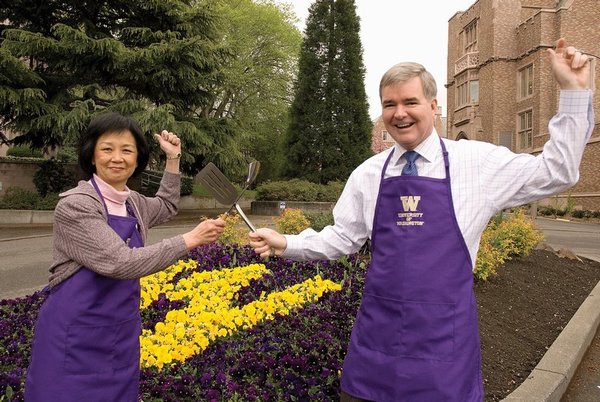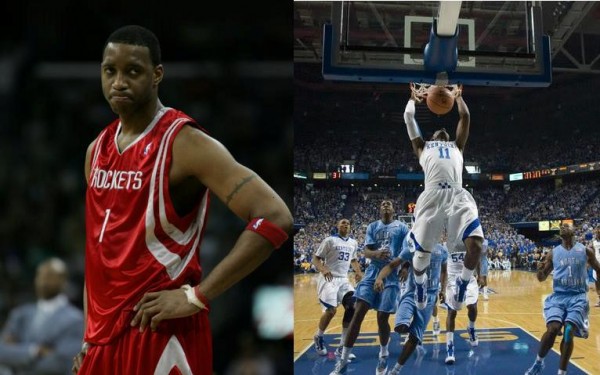Posted by rtmsf on May 31st, 2007

Wilbon, as usual, is up in arms.
Today we wanted to take a moment to examine an idea put forth by the inimitable Mike Wilbon in Monday’s Washington Post. Wilbon’s essential take (written after game 3 of the Detroit-Cleveland series) was that much of Lebron’s struggles in late-game situations of the NBA playoffs is directly attributable to his lack of “big game” experience, which his predecessors (Magic, MJ, Bird, etc.) honed and developed during the crucible of March Madness. He wrote:
LeBron’s bigger problem is never having learned how to play these kinds of high-stakes games in college — and now having to learn against a recent champion. Most every iconic player in NBA history, particularly the triumvirate of Magic, Larry Bird and Michael Jordan, learned to play big games during March Madness. For every Kobe (who had Shaquille O’Neal), there’s an Isiah Thomas or Dwyane Wade or Richard Hamilton, guys who learned how to deal with the enormous pressure of big games in college, then successfully transitioned into the NBA playoffs. It’s no coincidence that Tracy McGrady and Kevin Garnett, who also skipped college, struggle so mightily in the playoffs. Without Shaq, Bryant is 0 for 2 getting out of the first round of the playoffs.
Since the high school-to-NBA era began in 1995 with Kevin Garnett, there have been 28 first round picks used on US kids a month removed from their high school graduations. It’s too early to say for many, but early returns suggest that only seven were definitely worth the pick – KG, Kobe, Jermaine O’Neal, T-Mac, Amare, Lebron & Dwight Howard. Others such as Shaun Livingston, Al Jefferson, Andrew Bynum and the two Smiths – Josh and J.R. – may end up being stars in a few years, but for now it’s too early to tell.
Of that group of high school-to-NBA superstars, and with the very notable exception of Kobe as first lieutenant second banana to Shaq, how many of that group have led their teams to postseason NBA success? The struggles of KG (2 playoff series wins in his 12-yr career) and T-Mac (0 series wins in 10 yrs) are well documented, although Jermaine O’Neal (3 series wins in 7 yrs as a starter in Indiana) may soon also warrant inclusion on that list. Still, Amare (5 series wins in 5 seasons in the NBA – assist to Steve Nash) and Lebron’s (3 series wins in 4 seasons) rather quick starts confound Wilbon’s blanket theory a bit. It’s too early to say with Dwight Howard.
For now, we think there is some validity to Wilbon’s theory, but it’s not as clear-cut as he suggests. The NCAA Tournament’s knockout format eliminates pretenders from contenders very quickly, and the teams with gamebreaking talents who can keep their cool and make plays at the end of games are usually the ones last standing. But where we feel Wilbon’s argument fails is that it’s very difficult to go deep in the NBA playoffs for just about anyone, whether a four-year college player or one who skipped it altogether. During the era of which we’re speaking (96-07), only five franchises have won NBA titles (Chicago, San Antonio, LA Lakers, Detroit, Miami), and it appears that one of those same franchises will win again this season (SA or Detroit). History tends to show that only age and collapse from within creates a vacuum by which a different NBA franchise can rise to the top of the heap.


Shaq & Laettner have had different degrees of success in college and the NBA.
With so few historical opportunities for superstars to elevate their teams to the highest level of the sport, we find it somewhat unfounded to correlate the amount of time spent playing in March Madness as an indicator of future NBA playoff success. After all, didn’t Shaq (4 NBA titles and 123 playoff wins) flame out early every year at LSU, winning a grand total of two NCAA Tournament games in his three seasons in Baton Rouge? Conversely, Christian Laettner won 21 NCAA Tournament games at Duke, but his NBA teams only won 11 playoff games where he was a significant contributor (note: he also averaged 2.2 ppg in 11 more playoff wins with the Heat in 2005). There are undoubtedly other examples that will support both viewpoints. We tend to believe that the those who are destined to become superstars will ultimately use their talent and drive to work their way to that level, and whether those players learned how to do that in college or on the job in the L doesn’t really matter. Tonight Lebron will have his biggest opportunity yet to prove us right.
| nba playoffs, rtc analysis
| Tagged: amare stoudemire, christian laettner, duke, dwight howard, high school to nba, jermaine o'neal, kevin garnett, kobe bryant, lebron james, lsu, march madness, michael wilbon, nba playoffs, nba title, ncaa tournament, shaquille o'neal, tracy mcgrady, washington post
Share this story















































